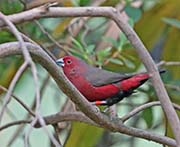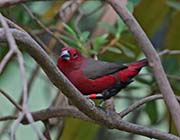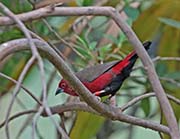African Firefinch - Lagonosticta rubricata
| Length | |
| Weight | |
| Clutch Size | |
| Chicks at birth | |
| IUCN Conservation Status | |
Continents: |
The African Firefinch is one of 10 species of firefinches and is also known as the Blue-billed Firefinch. It is a common bird found throughout Africa south of the Saharan Desert. The male is mostly red that tends to be more brown on the upperparts. The undertail covers and part of the belly is black. The eyes are dark with a pinkish eye ring. Female and juvenile African Firefinches are mostly brown with some red on the rump and face. Only adults have white spots on the sides. The adult bill color is a silver blue.
The Red-billed Firefinch is heavily parasitized by the Village Indigobird.
Because of the area that the African Firefinch is found in, the bird is considered of 'Least Concern' for extinction by the IUCN.
Diet: African Firefinches mostly eat seeds. During breeding they also eat small insects. They feed in pairs or family groups on the ground.
Courtship: African Firefinches can breed throughout the year when conditions are suitable. Seasonal peaks are during or following periods of rain. African Firefinches are believed to be monogamous. If one of them dies, the other will seek out a new mate. African Firefinches are not solitary birds. You will normally see them in pairs or flocks.
Nesting: The African Firefinch builds its nest in the branches of a tree or a shrub. The female lays 2-5 white eggs.
Habitat and Range: The African Firefinch is found in most of the countries south of the Saharan Desert all the way to South Africa. They utilize quite a few different habitats including subtropical/tropical, dry, rivers/stream/creeks, woodlands and grasslands.
Plumage/Molt African Firefinches do not have an alternate or breeding plumage. They molt annually and the adults may become flightless for up to 3 weeks between December and March when moulting their fight feathers. During this time they hide in vegetation near water.
Migration: This species is mostly sedentary but is a local migrant. Their movements are related to seasonal rainfall and the filling up of temporary waters. Young birds may also undergo extensive dispersal movements that are not linked to rainfall.
Bibliography:
- http://en.wikipedia.org The Free Encyclopedia, Accessed July, 2012
- http://birdlife.org BirdLife International, Accessed July, 2012
- http://www.kenyabirds.org.uk/ Kenya Birds, Accessed July, 2012
- http://www.thekruger.com/directorybirds.htm Kruger National Park, Accessed July, 2012




